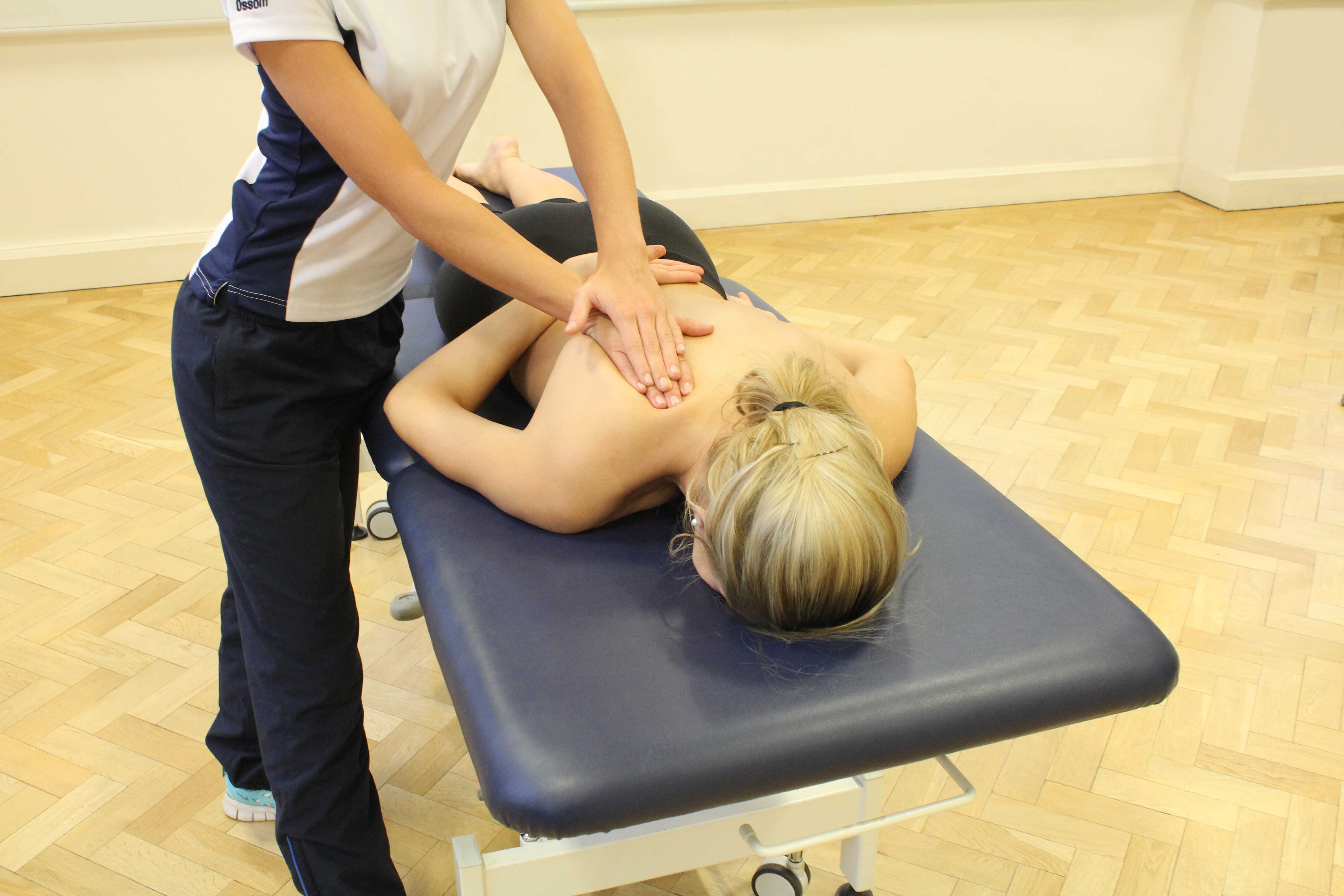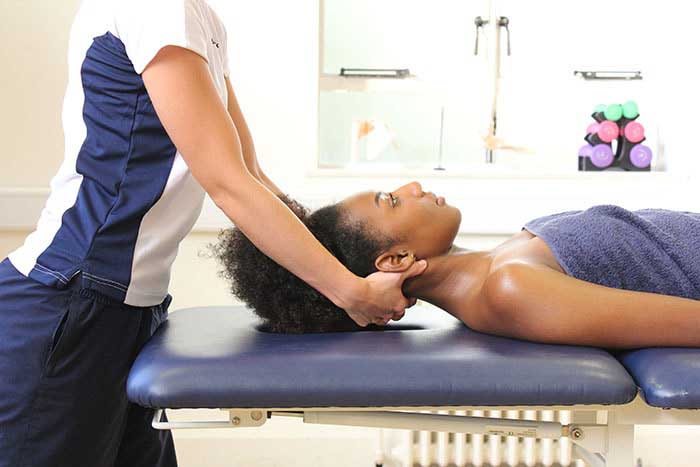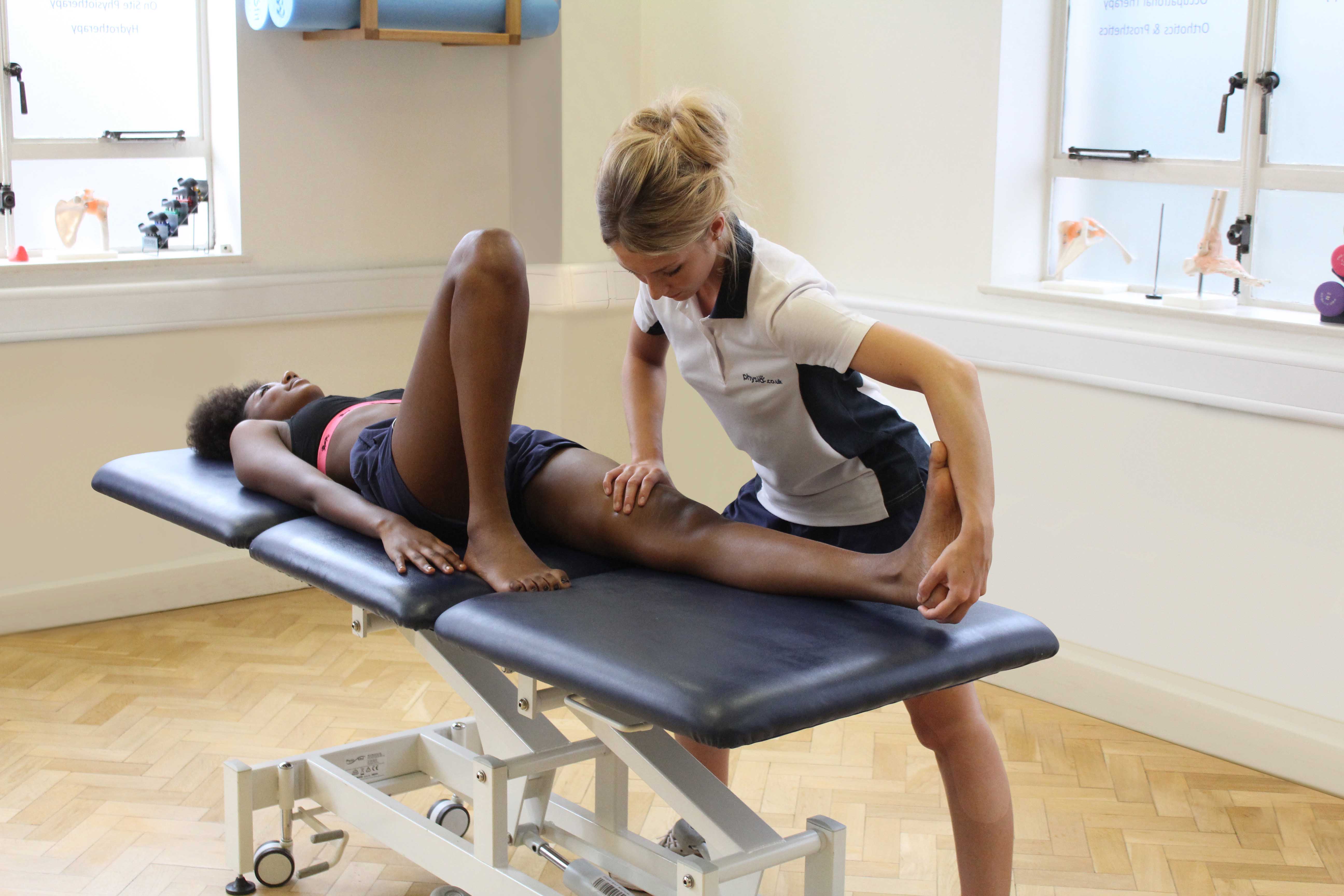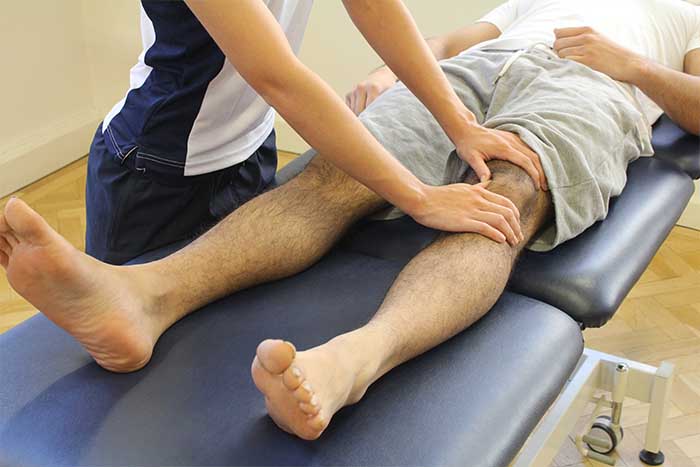Decreased tension is a common benefit gained through massage. Tension is where muscles stay in the state of contraction and are unable to relax. Muscle tension can increase restriction, pain and muscle tightness. A massage helps to decrease tension by encouraging the relaxation of muscles resulting in reduced pain and decreased restriction. Our massage therapists at Physio.co.uk decrease tension through massage to help reduce restriction, decrease pain and increase movement.
What are the most appropriate types of massage to decrease tension?
A range of different types of massage can be used to decrease tension. The most common types of massage used include:
 Above: Soft Tissue Massage targeting trapezius back muscles
Above: Soft Tissue Massage targeting trapezius back musclesThe most appropriate types of massage used to decrease tension include deep tissue massage, therapeutic massage and remedial massage.
Deep tissue massage can be used to decrease tension. A deep tissue massage is used to treat the deeper layers of muscle and fascia within the body. Fascia is a layer of connective tissues that is very fibrous and restrictive. A deep tissue massage involves applying a firm pressure to the treatment area to help release tension and decrease pain. Adhesions are also reduced through deep tissue massage. Adhesions are bundles of muscle fibres grouped together as a result of a build-up of muscular tension. Breaking down adhesions helps to decrease tension.

A common type of massage used to decrease tension is therapeutic massage. A therapeutic massage involves using a variety of different strokes to manipulate the body into producing a therapeutic effect. Therapeutic massage encourages the relaxation of a person physically and mentally. A therapeutic massage relaxes a person physically by encouraging the relaxation of muscles, reducing tension and pain. Relaxation is improved mentally by stimulating the release of endorphins, serotonin and dopamine. Endorphins, serotonin and dopamine are all positive hormones that promote a sense of well-being and gives a person an improved mood.
Remedial massage is often used to decrease tension. A remedial massage focuses on manipulating the superficial and deep muscles within the body. Remedial massage can increase relaxation, decrease tension and reduce stress. Remedial massage also encourages the body's healing process to speed up to help further relieve tension and pain. A firm pressure is used within remedial massage to help get deeper within muscle fibres to ensure full relaxation of deeper muscles as well as superficial muscles.
What techniques are used to decrease tension?
There are a variety of techniques used within a massage to help decrease tension. The techniques most commonly used include:
 Above: Achilles tendon and calf stretch
Above: Achilles tendon and calf stretchThe most common techniques used to decrease tension include deep strokes, skin rolling and trigger pointing.
Deep strokes can be used to decrease tension. Deep strokes are used on areas containing soft tissues. A firm deep pressure is applied to the treatment area using flattened hands a fingers. Deep strokes aim to get deep within muscle fibres to. Muscle tissues increase in temperature during deep strokes, increasing tissue elasticity. An increase in tissue elasticity helps to stretch and loosen a muscle allowing it to relax. A relaxed muscle decreases tension and any pain that has occurred.
Skin rolling is regularly used to decrease tension. Skin rolling is a technique that involves picking up skin and rolling it between the fingers and thumbs. Skin rolling encourages an increase in blood flow during a massage due to friction created between the skin and fingers. An increase in blood flow causes a rise is muscle temperature, improving tissue elasticity and flexibility. Skin rolling helps to stretch and loosen muscles as well as separating muscle from fascia. Fascia is made up of tough connective tissues that can cause restriction and increase tension. Separating muscle and fascia allows muscles to relax and decrease in tension.
Tension can be decreased using trigger pointing. Trigger pointing involves applying a firm pressure using the fingertips or thumbs to specific areas on the body. A trigger point is found in the middle of a muscle fibre at neuromuscular joints. Areas containing trigger points are often found to be full of tension, tightness and stress increasing pain and restriction. When pressure is applied to the trigger point, a person will feel an increase in pain due to the compression of the nerve. After a short period of time, a numbing sensation will occur as blood flow is restricted, allowing the trigger point to be broken down and softened. When pressure is released and increase in blood flow occurs helping the muscle to relax and also to repair damage muscle fibres. Trigger pointing helps to release muscular tension, tightness and stress resulting in a decrease in pain.

When can a massage help to decrease tension?
A massage can help to decrease tension in many situations. The most common situations a massage can help to decrease tension include:
The most common situations a massage can help to decrease tension include acute pain, pre event and relaxation.
Decreased tension through massage can help reduce pain. A build-up of tension within muscles can cause muscular knots and adhesions. Muscular knots and adhesions cause muscles to tighten and restrict movement, increasing pain. During a massage, the relaxation of muscles is encouraged as tissue elasticity and flexibility increases. Relaxation of muscles decreases tension and tightness. A decrease in tension and tightness makes it easier for muscular knots and adhesions to be broken down and pain to be reduced.
Massage can help to decrease tension pre event. Before an event, muscles tend to be tight and full of tension. Muscle tightness and tension restricts movement and disables a muscle from reaching its full length during a stretch. Restricting movement increases the risk of injury during the event. A massage decreases tension by increasing muscle temperature. An increase in muscle temperature improves muscle flexibility allowing it to stretch and move more freely. Free movement and the ability to stretch help to decrease tension and increase range of movement. An increase in range of movement reduces chances of injury during an event.
A decrease in tension by massage can help improve relaxation. When muscles are tense, physical and mental relaxation is reduced. Relaxation is reduced physically as muscles stay in the state of contraction, increasing pain and muscle tightness. Relaxation is reduced mentally due to the pain created by muscular tension. A decrease in tension through massage enables muscles to loosen and relax to help increase physical relaxation. Loosened and relaxed muscles also decrease pain and increase range of movement, mentally increasing relaxation.
What are the physiological effects of massage to decrease tension?
Various physiological effects occur during a massage to help decrease tension. The most common physiological effects that occur include:
The most common physiological effects that occur during a massage to help decrease tension include increased vasodilation, increased temperature and increase tissue elasticity.
A common physiological effect of massage that occurs to decrease tension is increased vasodilation. Vasodilation involves the relaxation of smooth muscles lining blood vessels resulting in their dilation. Vasodilation widens blood vessels and brings them closer to the skins surface, giving the pinking effect on the surface of the skin. Increasing vasodilation allows an increase in blood flow to occur. An increase in blood flow can be used both to increase muscle temperature and for the repair of damaged muscle fibres. Increasing temperature allows muscle to relax reducing tension. Increasing the repair of damaged muscle fibres decreases pain and loosens muscles that have tensed up to help protect and support the damaged area.
Increased temperature is a common physiological effect of massage that helps decrease tension. Increased temperature is the process of increasing blood flow to encourage a rise in temperature in both superficial and deep tissues. Muscle temperature is increased as friction created between the skin and fingers encourages an increase in blood flow. Muscle tension results in the contraction of muscles that are then unable to relax. Increasing muscle temperature improves tissue elasticity and flexibility. An increase in tissue elasticity and flexibility provides muscles with the ability to stretch further and loosen, resulting in muscle relaxation. Muscle relaxation through increased temperature decreases tension.
A physiological effect of massage to decrease tension is increased tissue elasticity. Tissue elasticity is where a muscle has the capability to stretch to its full length with no restriction or pain. When muscle tissue become restrictive, they often tend to become tense increasing pain. Tissue elasticity is increased due to a rise in muscle temperature during a massage. An increase in tissue elasticity provides muscles with increased range of movement and allows the muscle to stretch and move more freely. Allowing muscles to stretch and move more freely reduces restriction and decreases tension.
Summary
Decreased tension is allowing a muscle to relax and loosen after staying in the state of contraction. A variety of massage are appropriate to decrease tension including deep tissue massage, therapeutic massage and remedial massage. A wide range of techniques are used within a massage to help decrease tension, the most common being deep strokes, skin rolling and trigger pointing. A massage can help to decrease tension in many ways including acute pain, pre event and relaxation. Increased vasodilation, increased temperature and increased tissue elasticity are all physiological effects that occur during a massage that help to decrease tension. Our massage therapists at Physio.co.uk decrease tension through massage to help reduce stress and increase range of movement.
How can I arrange a massage to decrease tension?
The easiest way to arrange a massage to decrease tension at Physio.co.uk, email us at office@manchesterphysio.co.uk or call us on 0161 883 0077.
You can also book an appointment online and save £10

 0330 088 7800
0330 088 7800


































